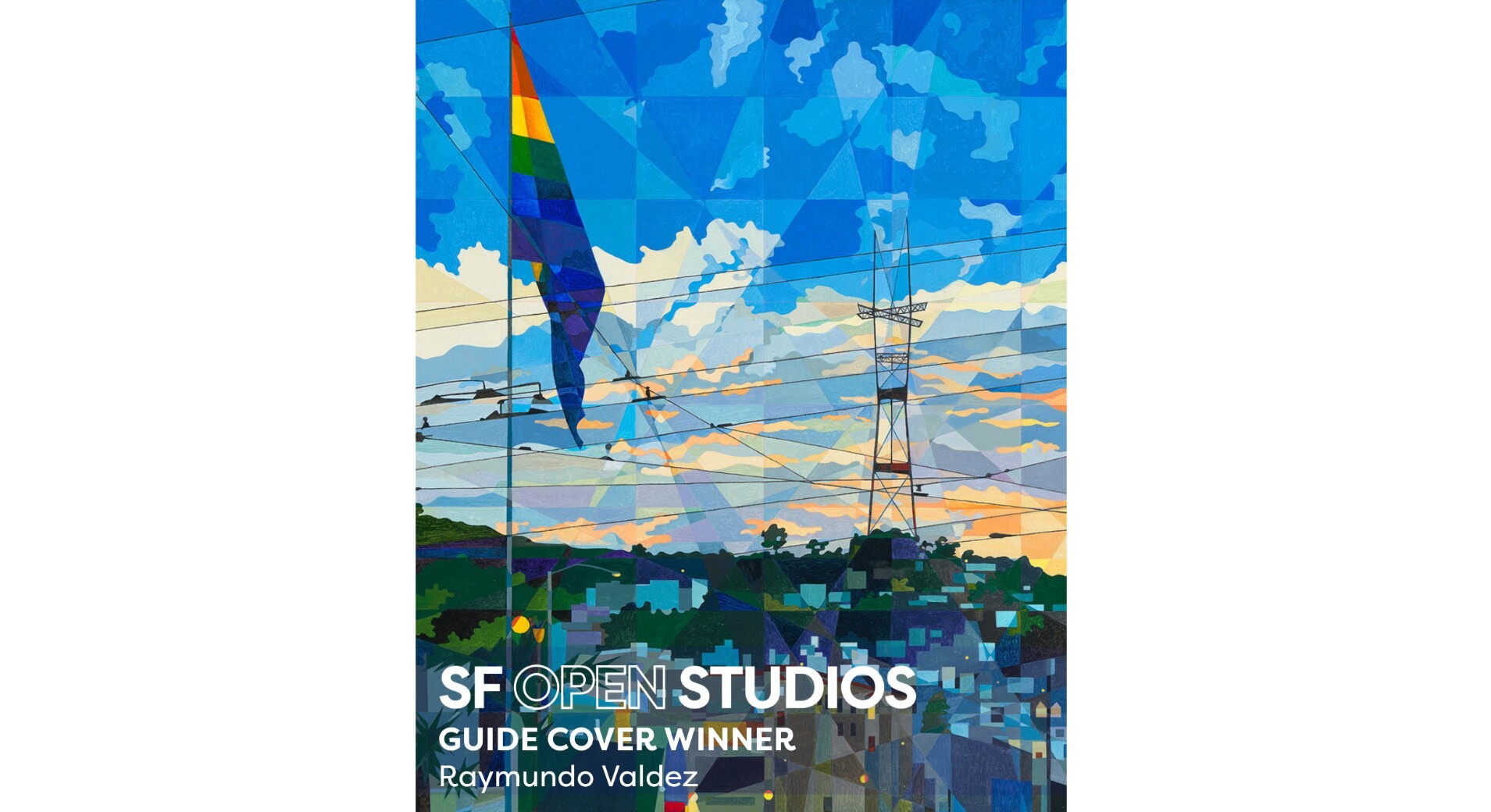San Francisco Open Studios 2025 - by Artspan
Step 0 of 0
1

2
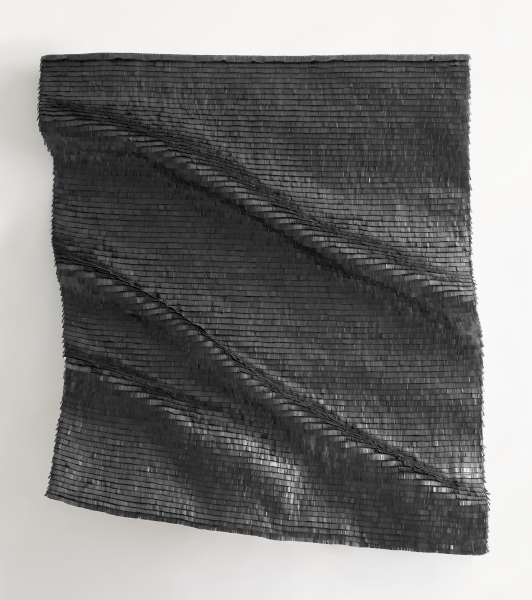
3
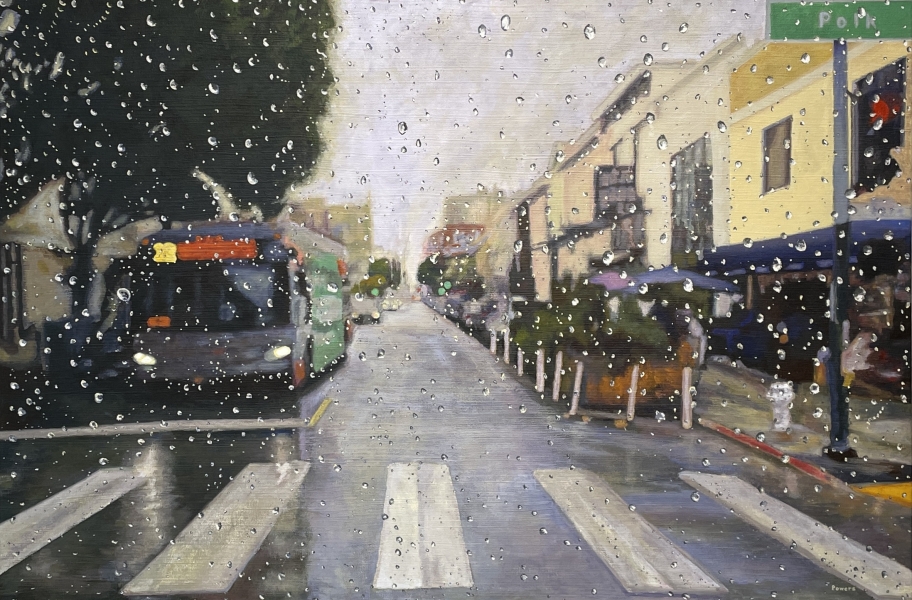
4
5
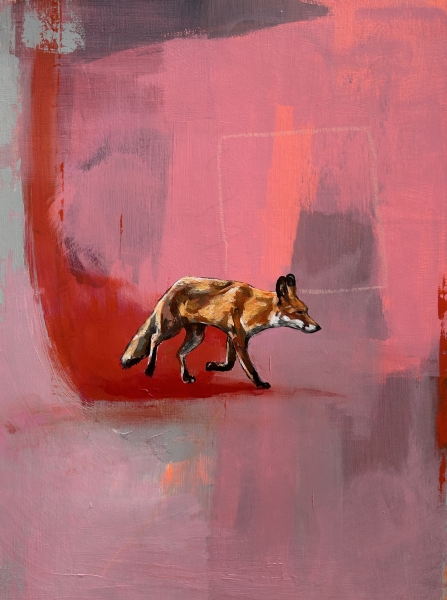
6
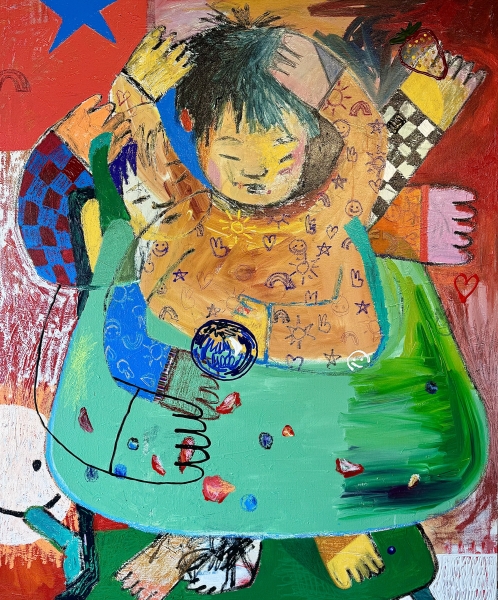
7
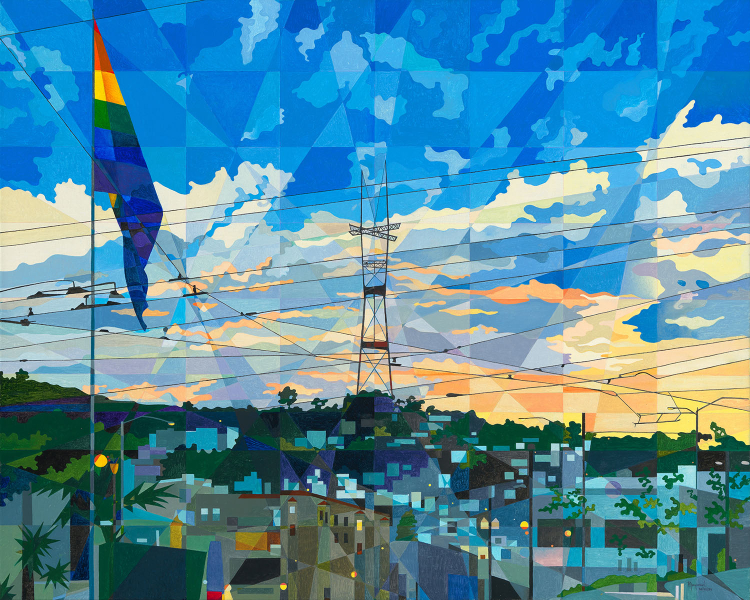
8
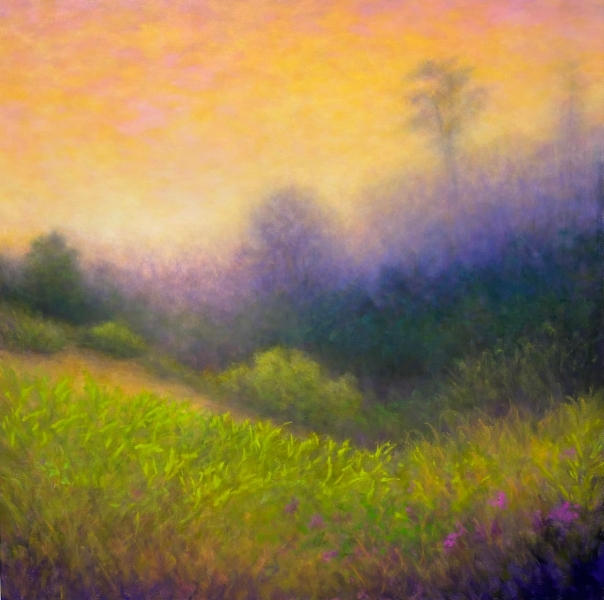
Connector - Bushra Gill - 2025
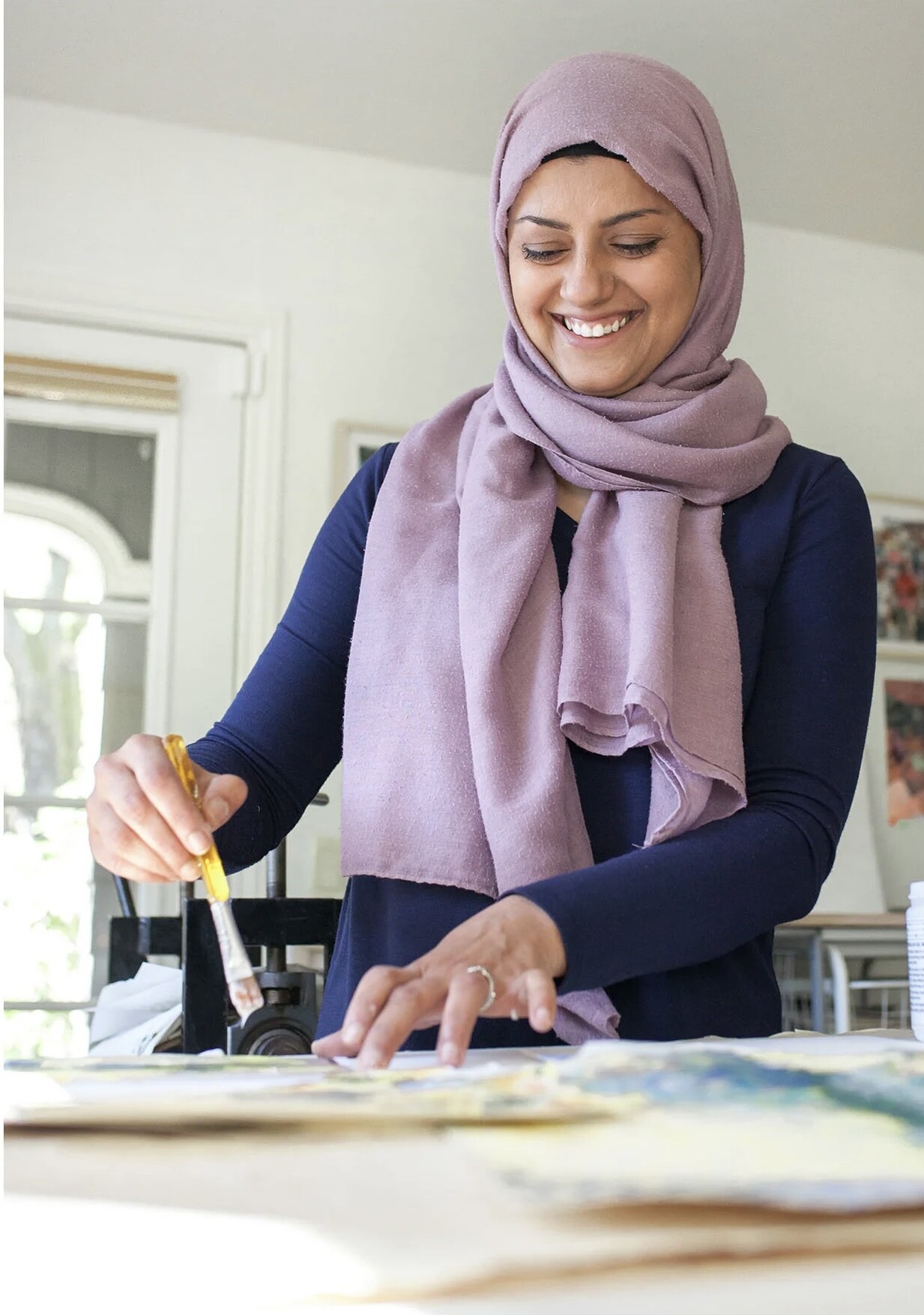
Bushra Gill is an artist and curator who finds order within the chaos of everyday life through art.
She was born in Karachi, Pakistan, and emigrated to Houston, Texas, with her family as a small child. Drawn to art from a young age, she graduated from Pratt Institute in 1994 with a BFA in sculpture. She has been awarded residencies at Pilchuck Glass School and Kala Art Institute. Gill spent many years working as a museum educator at various galleries and museums including The Museum of Modern Art, The Drawing Center and The Rotunda Gallery, while also working as a studio assistant to various artists including Maya Lin, Ursula von Rydingsvard, and Maria Elena Gonzalez. Currently living and working in northern California, Gill also curates, drawing on her experience from a long teaching career to be a visual storyteller. She is a member of the California Society of Printmakers, the Northern California Women’s Caucus for Art and Asian American Women Artists Association.
Having emigrated at a young age, I’ve often experienced the tension of feeling included while remaining somewhat apart. This sense of in-betweenness informs my work, where I explore themes of connection—particularly the hidden structures that link us to each other, to nature, and to the larger dimensions of time and space.
Inspired by Islamic geometric patterns, I tessellate everyday imagery, tiling small shapes to build richly layered surface structures using paint, print, and wood collage. Through this process, my subjects are both revealed and obscured, reflecting my interest in what is simultaneously visible and veiled—much like my hair, which I cover with a scarf in public. Layering—whether through pattern, imagery, or pieces of wood—has become a foundational strategy in my practice, allowing the work to evolve from low-relief surfaces into sculptural forms.
The repeated geometric forms I use create a visual order that helps me make sense of the natural world and my own lived experience. The framework supports experimentation and lets me lean into flaws to make the work more human, and that pushes me to reconsider boundaries of color, texture and spatial perception. I'm especially drawn to the broken edges and missteps, because they automatically free me from perfection and allow my voice to be heard.
I'm Bushra Gill. I made this piece called Connector about my mother. As a teacher and a lifelong learner, my mother Usra Gill, she loves connecting people with threads of information. She began her career as a history lecturer, but has always immersed herself in studying Arabic and Quran. But then when my sisters and I got older, her motherhood duties relaxed and she started teaching much more. So she always says that she has many daughters, only like, although only 3 by birth. Many women call her auntie and credit her with opening their minds through both her teaching and her example. I saw this firsthand for an extended time a few years ago when I went to care for her after she had an accident. Her body was really frail, but her intelligence and spiritual strengths were indomitable. So the Islamic geometric patterns that I use remove the individual details, leaving the structure, which kind of symbolizes my mom's journey and faith.
Tom Paper: So tell me about the piece itself. This is a this is a sculptural piece, correct?
Bushra Gill: It's a wall mounted piece. It's a laser cut wood with an image transfer of her picture on it, and then on top of that, I've painted um the shapes, the the the Islamic geometric patterns, which are also cut outs, the edges are cut out. And there's also hope that some of the shapes have been cut out. I designed these panels and then have them cut and then use them as like both as printing plates and then as as painting of their own accord.
Tom Paper: I was gonna ask you about your journey, like your artistic journey. When did it when did it begin and how has it evolved?
Bushra Gill: I don't remember when my artistic journey began because I've always said that I was going to be an artist, like from when I was a kid. But I guess, you know, more formally, I went to art school, I went to Pratt, and then I made work for a little while, but then I kind of stepped away from art for a little bit. I went, I had, my mom also taught me how to sew, so I became a designer. I was a clothing designer for many years. And then, so she's kind of been a part of my life, you know, a big part of my life and not just as a mother, but also as an influence. because I also then became a teacher. So I was a teacher for a long time. And then watching her become a, you know, like become a teacher again after, you know, like giving up her teaching career shortly after, like, when she got married. And so the piece is made of laser cut wood, which I use more because it's, I like the kind of broken edges and the way that kind of like lets you sort of enter the space rather than, you know, like a flat rectangle. Um, and then there's what it's a little hard to see in the picture, but there's like little shapes that are also raised up off of it. Um, and I would say the hardest part with these paintings is to get them to be more abstract. It's very easy for them to be very realistic, but I really want to emphasize the abstract nature of it because I feel like that that's a point of entry like we, I want to be able to show that there's this idea of a pattern that connects everybody that that connects everything in the universe, you know, like that, that it was all made that there's a, there's a structure underneath and so um that's what the pattern symbolized for me and I thought that was especially, you know, apt for, for her and for what she's doing.
Drape of Noir - Cécilia Lusven - 2025
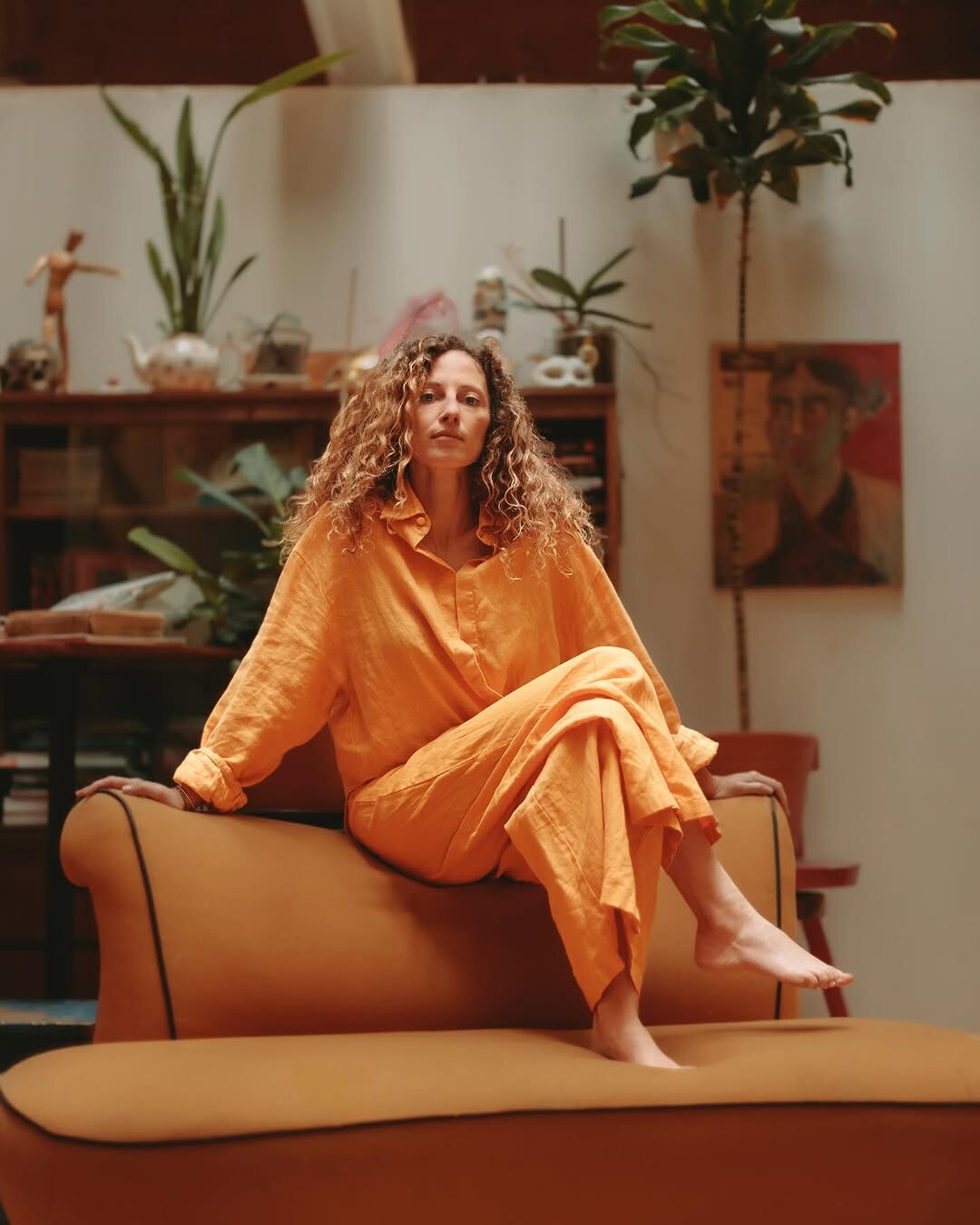
In her words:
Through my work, I desire to bring a sense of awareness and appreciation for the dedication and intricacy that lies at the heart of weaving. Each piece is a testament to the laborious process, where every hand-cut fringe is meticulously inserted, one by one, revealing the journey of each thread – coiled, warped, beamed, threaded, tensed, and finally woven. My work challenges the trivialization of the textile practice brought on by industrialization, by bringing together art and the common.
I use discarded materials or scraps of leather to echo this devalued textile practice. These materials are transformed through my hands as I hand-cuts then hand weave and sometimes hand stitch them with dead stock linen threads from shoemaking or bookbinding.
My process is not just about reclaiming materials ; I see my work as an exploration of landscapes both internal and external encouraging a reflection on our interactions with both our environment and one another.
Instagram: @cecelia_lusven
Hello, I'm Cécilia Lusven. I'm here to talk about Drape of Noir, that's the name of my handwoven textile piece that I'm presenting today. So this piece is a metaphor to highlight what is often overlooked. So the idea is to remind that we can have a flexible vision of the world. I grew up in a family with a very Cartesian dad and an artist mother. So I think that brought me the possibility to have different visions of what the world can be and that helped me to keep my child's eyes, I think, in that way. And when you don't know what something is made for, it can be anything. And I think that's what I wanted to translate in that piece because making it with discarded inner tubes represents that idea that if I had no idea what the inner tubes I was supposed to be used for, I could just like play with it and make it whatever. So that that's the idea behind that. So more generally, I always use discarded materials to I think I like to find a new destiny, a new environment that will make them more interesting, or just different and will bring people to see a new aspect of them and rethink what they think they know. So that's the main idea behind most of my weavings, and I think this one also reflects obviously visually the flexibility of the textile, because sometimes people forget that it's a textile that I'm making because we are not seeing any threads from the facade, but it is a handmade, hand-woven textile.
Cheese Plus: Polk at Pacific - Mark Powers - 2025
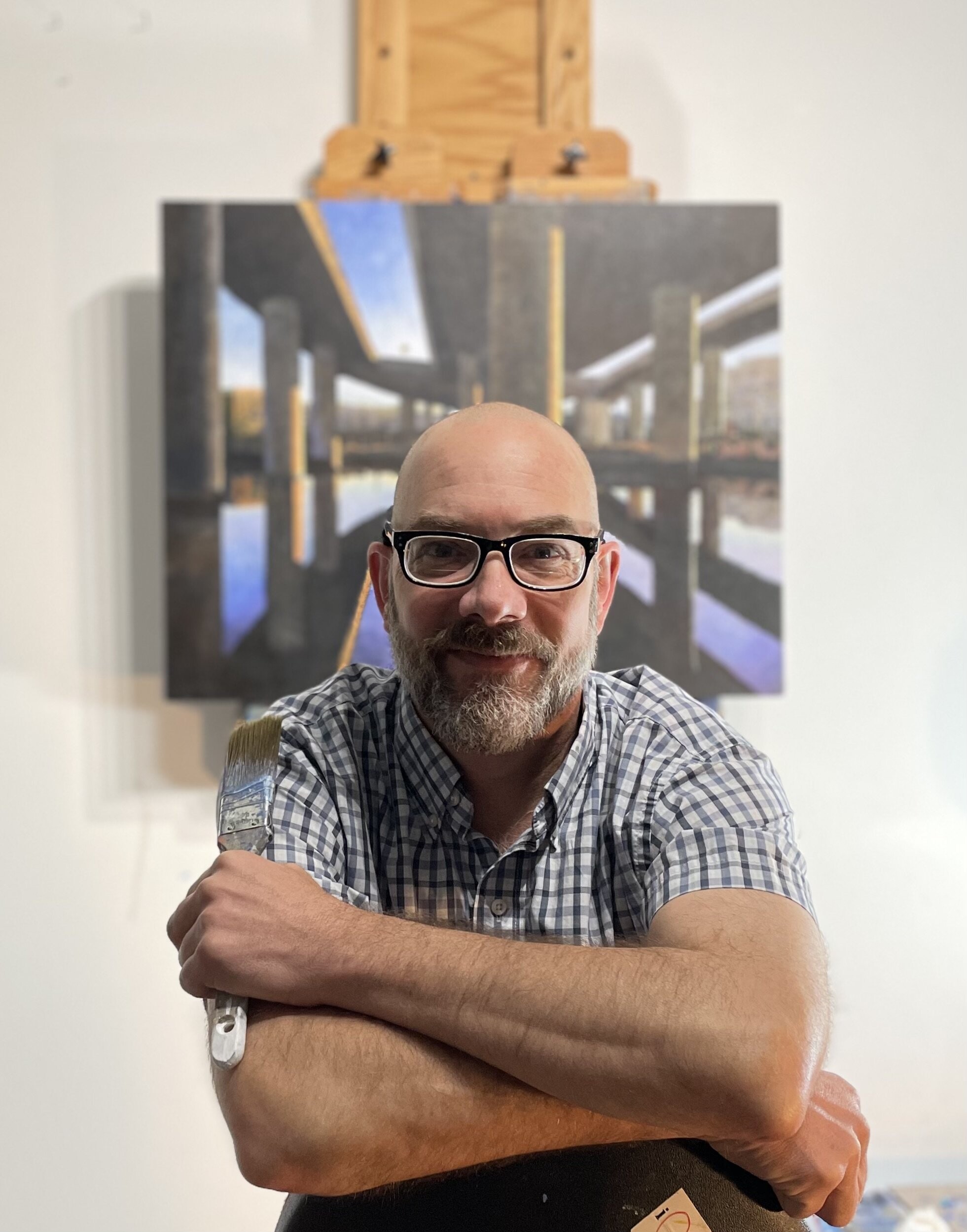
Mark is a San Francisco based painter who uses painting as documentation and storytelling. With a well practiced artist’s eye, Mark spends a lot of time capturing situations (mostly in California), curating the most paint-worthy moments into references for future series, and ultimately translating those moments with tremendous care and attention.
If he’s not painting, he’s drawing. If he’s not drawing, he’s probably thinking about painting, or light, or shadows…
Instagram: @markdpowers
Hi, my name is Mark Powers, and we are here to talk about my painting Cheese Plus: Polk at Pacific, which is an acrylic painting on canvas. And this is part of my driving around or driving shotgun series where I take a lot of photos from inside of a vehicle and this one happens to be inside of a vehicle looking through the glass on the car with wet raindrops on the glass and so I take the photos, I take thousands and thousands of these kinds of photos and go back and select the ones that I think are going to make worthy paintings. And in this case, uh. I did several sketches of this particular piece before I executed it, and then the final piece I took to canvas and basically did the background first, which is in this case sort of a fuzzy background, and most of the focus in this painting is actually on the raindrops, so you'll see them as being a lot more clear than the background of the image, this particular location, like I said, it's titled Cheese Plus: Polk at Pacific. It's actually in the Polk District of San Francisco and in the painting on the right, you'll see the front of a restaurant called Cheese Plus, which is a wonderful deli style, nice wonderful shop that I frequent quite often. And on the left, you'll see a bus coming up Pacific toward Polk Street. So we're just, I'm driving across Polk Street looking down Pacific in this piece.
That's great. You've been an artist for how long and how did you get your start and how is your work evolved? I've been an illustrator for many, many years, mostly as a hobby I would say, and, and about 8 years ago I decided to become an artist full time and that's when I started painting. So I picked up the paintbrush and started doing. Unlike my drawings, which are very almost abstract expressionist, and surreal, my painting and the process and direction of my paintings. As to my surprise, been very realism-based, that just seems to be where my brain has taken me. So I've been honing this, this particular side of my craft, which is this realism painting. Uh, and it's been one heck of a journey. I've been in a couple of museums in the last 8 years working with several art consultants and a lot of galleries, so it's been pretty exciting journey so far. I submitted this piece for the competition to, uh, to be used for print collateral and promotions for Open Studios and was absolutely delighted that uh it was accepted as one of the runner-ups.
Mark Powers completing Cheese Plus: Polk at Pacific
Forward Thinking - Michael McConnell - 2025
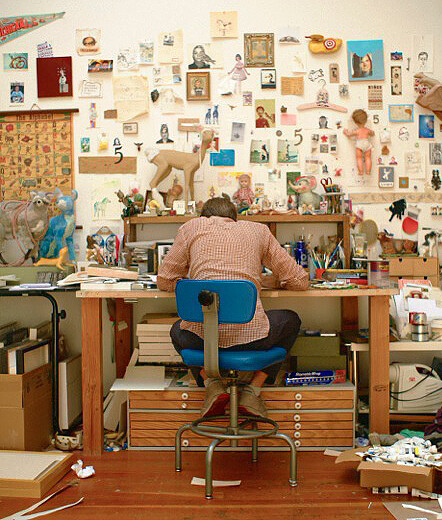
Michael McConnell was born in Michigan, where he used to watch squirrels from the front window. He studied art at the Columbus College of Art & Design, with an emphasis in lithography and painting. After graduating from CCAD, he packed up a U-Haul and drove across country to the Bay Area, where he now lives in San Francisco. In the past 20+ years he hasn’t found a good reason to leave.
Currently Michael’s art can be found at Poet and/the Bench in Mill Valley. Michael was represented by Braunstein/Quay Gallery in San Francisco for 10 years, but since their closure, he has been on the lookout for new gallery representation. He has enjoyed showing with Gauntlet Gallery in San Francisco, Marion and Rose’s Workshop in Oakland, and Abrams Claghorn Gallery in Albany. If not in his studio, you can find Michael drinking coffee at his Fayes Video in the Mission District, dancing, or playing light sabers with his family.
Instagram: @poopingrabbit
Making art is how Michael makes sense of the world and his forgotten childhood. Observing his own anxieties and awkwardness, he creates visual narratives that examine loneliness, responsibility, and choice. In his work, the innocence and vulnerability of children and animals are constrained. The stories unfold in the space between memory and nostalgia, and focus on the tension between youth and maturity.
Hi, my name is Michael McConnell. Um, I'm a San Francisco-based artist. I've been working in the Bay Area for the last 26 years. I've been involved with ArtSpan for about 21 of those years, and so it's been an honor to have this piece selected as a finalist for the upcoming Open Studios this October. This piece is entitled Forward Thinking. A lot of people probably think of my work as being heavily based in like really stark solid backgrounds with an animal that's been isolated or whatever. Since COVID, I've exploring really a lot with more expressive color and a little bit more abstract painting, and some of my newer work, also has the subject matter is completely gone from the image. So this piece entitled Forward Thinking is kind of like, I've been in my head a lot and struggling with the idea of losing the animal, and what I can still say with color. And so when ArtSpan proposed the bold choices as their theme or bold, whatever, these bright pinks and reds associated with this red fox, I thought it was like the idea of like this forward trajectory. And then there's that little line of pink around the fox's head. It's kind of like a thought bubble for me, that's what it means, and just really look the momentum of going forward and where this exploration into color and abstraction may end up taking my work.
Berry Yummy - Michael Hyun Gu Kang - 2025
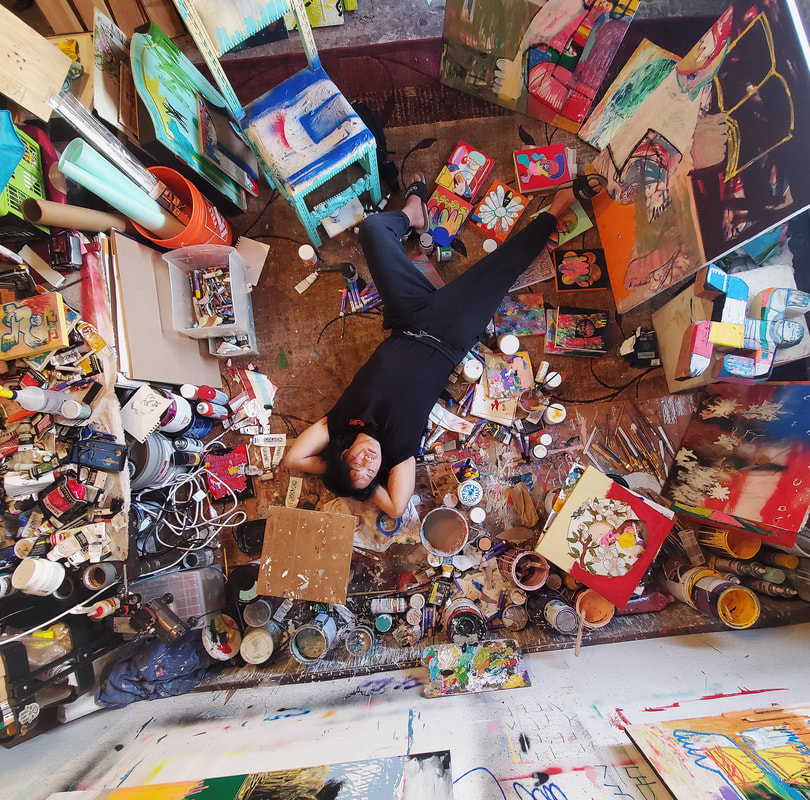
Michael Hyun Gu Kang is a Korean American painter whose practice explores identity, cultural memory, and personal narrative. Raised in the suburbs of Southern California, Kang’s work is deeply informed by his experience as a first-generation American, navigating the space between Korean ancestry and American popular culture12. His paintings frequently serve as visual diaries, capturing self-reflection and daily observations through bold colors, mixed media, and textured surfaces.
For over a decade, Kang has lived and worked in the San Francisco Bay Area. His creative process is characterized by experimentation with diverse materials—ranging from old rugs and doors to wooden panels and collaged found pieces—resulting in a rich, tactile quality that invites viewers to contemplate both the seen and unseen layers of his compositions2.Kang’s approach balances intuition and intention, often reworking paintings until they feel “destined” to be complete.
He has exhibited his work both locally and internationally, including at venues like Vessel Gallery and the Roll Up Project34. By engaging themes of tradition, motion, and translation across cultures, Kang renders the complexities of life as transformative and healing experiences, infusing each piece with dynamism, humor, and poignancy142.
Word count: ~200
- https://www.artsy.net/artist/michael-hyun-gu-kang/about
- https://www.artspanart.org/michael-kang
- http://www.rollupproject.com/exhibitions/michael-hyun-gu-kang/
- https://www.vessel-gallery.com/in-motion-with-michael-kang/
- https://www.instagram.com/mikehkanga/
- https://artsandculture.google.com/story/the-hyperrealistic-portraits-of-hyung-koo-kang/zQUBouR4VXMlKg?hl=en
- https://www.instagram.com/p/DCBartcTYcJ/
- https://en.wikipedia.org/wiki/Michael_Kang_(musician)
- https://www.artsper.com/ae/contemporary-artists/art-nouveau/south-korea?page=9
- https://www.linkedin.com/in/hyun-gu-kang
- https://koreajoongangdaily.joins.com/2019/04/09/etc/ZOOM-KOREA-Portrait-artist-makes-a-big-impression/3061620.html
- https://aaa.org.hk/tc/collections/search/library/33-korean-artists-by-33-best-critics
- https://meridian.org/profile/hyunmin-kang/
- https://www.macdowell.org/artists/michael-kang
- https://www.instantcheckmate.com/people/michael-hyun/
- https://www.globaltimes.cn/content/957683.shtml
- https://www.linkedin.com/in/michael-hyun-b374943a
- https://www.instagram.com/p/CESICg1BX3J/
- https://www.threads.com/@mikehkanga
- https://www.artsy.net/artist/michael-hyun-gu-kang
Hi, my name is Michael Kang, and I'm talking about my painting Barry Yummy. It's a painting of my son Otis. He was born 17 months ago today, actually, uh, during this recording, and it's just a painting of me capturing him, eating berries. And for anybody that has children out there, you know, that Berries is a very highly captivating for. Little babies and it's a it's just a different interesting experience watching him eat every time and I think I just enjoyed capturing the movement and kind of the chaotic energy of that and What it's been inspiring me lately is just. Trying to capture a little bit of everybody, every aspect of my life on a day to day basis, and I find obviously now that as a father in the past year or so, that, yeah, that has taken over everything, and it's been a pretty consistent. Unrelenting influence and direction change in my life. So I think you can see and feel that. In the whirlwind of his arms flying around and I just, just watching him do this thing, it's just kind of like a small snippet of our daily routine, you know, wake up. Time to eat breakfast. eats his food or doesn't eat his food. I make 3 breakfasts and he always ends up eating the berries. So, yeah, I just wanted to capture a small moment in that and I think if there was any details in the work that I really enjoy is there's one little tiny berry by his foot. In the in the painting like at the bottom of his high chair, and I felt like It's just indicative of every meal, just food, like in an unavoidable mess, even though it's only one little berry, it's just the, it's just the crumb, you know, like, and that's kind of what happens every single time. So I think this painting may be rela maybe in relation to some of my other work has tried to capture a moment. Either anxiety or joy, but movement and the moments like of my daily life, and yeah, that's where I'm at right now. It's, it's my son, he's eating berries. He's running his uh berry covered hands through his hair. I'm just spectating.
The Tower and The Flag - Raymundo Valdez - 2025
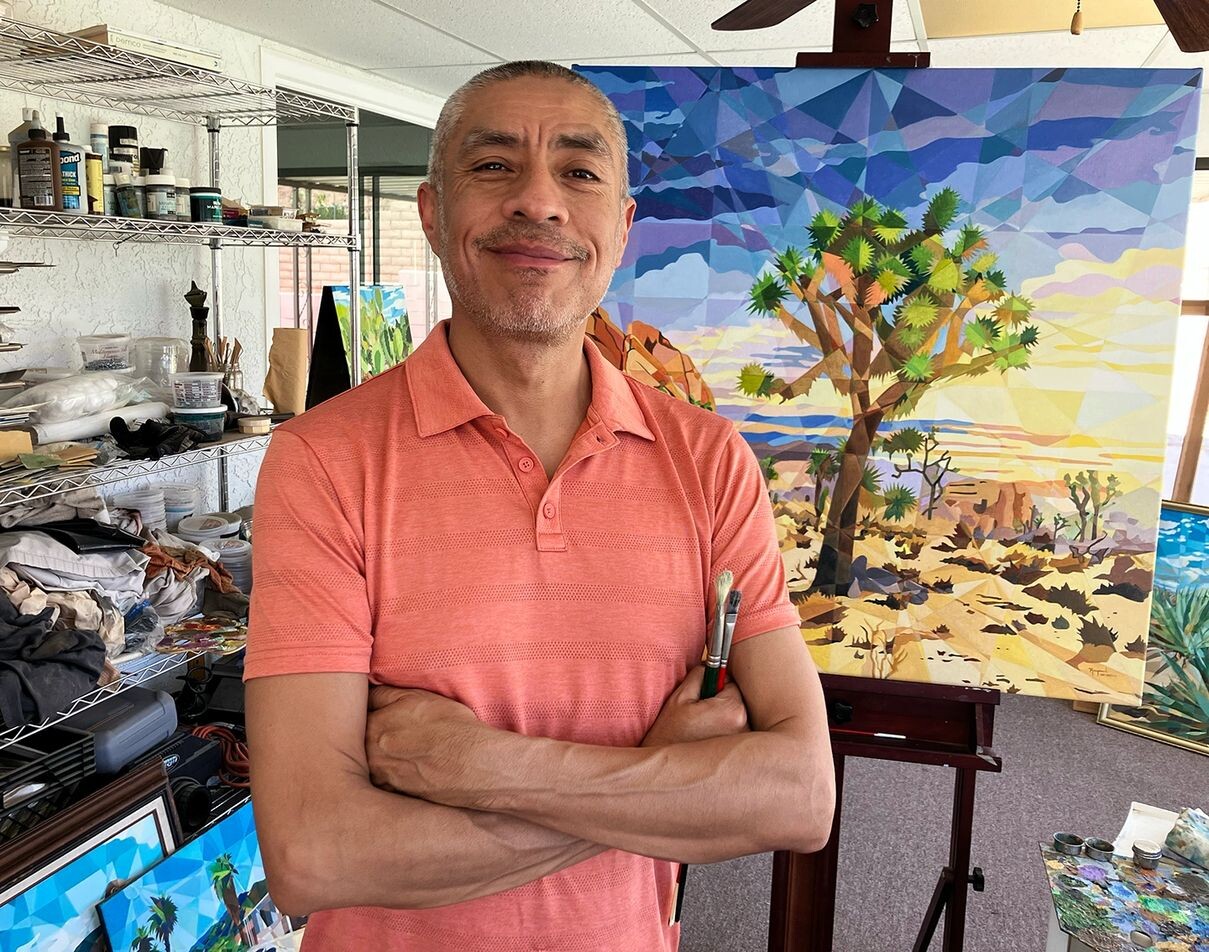
Raymundo, a renowned Mexican-American fine artist from Mexico City, has his work featured in private collections worldwide, including Buenos Aires, Dallas, San Francisco, and Palm Springs. He has also showcased his talent in numerous group exhibitions throughout the years.
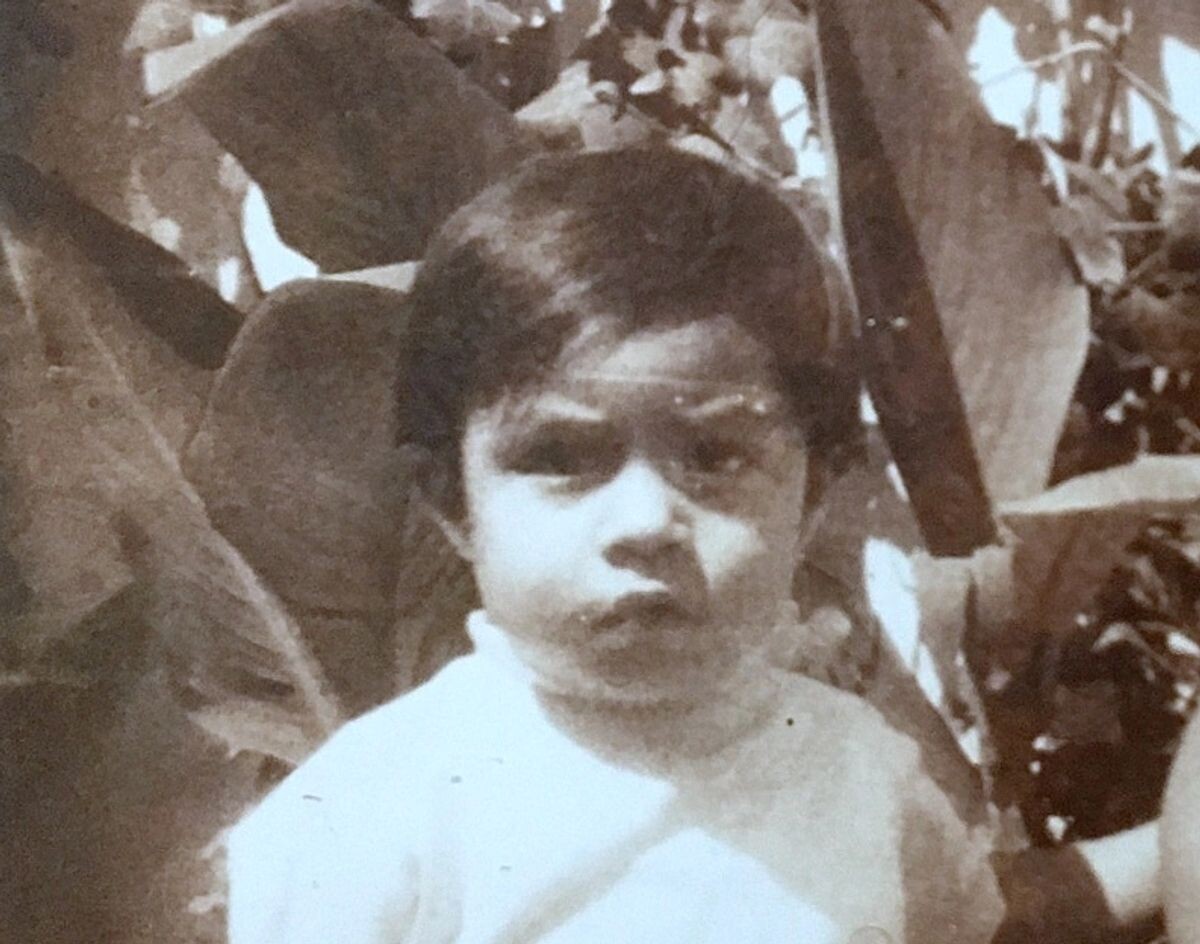
Raymundo's passion for art ignited during a school visit to Mexico City's National Palace, where Diego Rivera’s murals left a lasting impression. Captivated by shapes and colors, he began studying art as a child. Encouraged by his father, who enrolled him in piano, painting, and soccer classes, Raymundo quickly gravitated toward art, dedicating a decade to honing his skills.
Frequent visits to iconic art museums like Frida Kahlo’s and Diego Rivera’s houses, as well as the Museum of Modern Art in Mexico City, deepened his admiration for Mexican artists such as Rufino Tamayo and Francisco Toledo. This early immersion in art shaped his creative foundation.
With a degree in graphic design, Raymundo launched a successful career in advertising, working as an art director. However, his passion for painting remained. It wasn’t until he emigrated to the United States in 2004 that he fully dedicated himself to his artwork, finding both the time and drive to explore his creativity.
Traveling extensively over the years, Raymundo drew inspiration from the masterpieces of global art museums and developed a profound love for Asian cultures, particularly India and Southeast Asia. These influences continue to enrich his artistic vision.
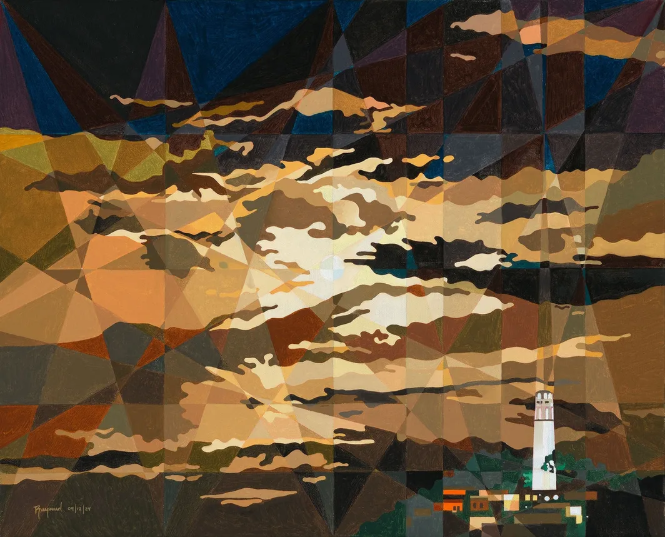
"Full Moon Over Coit Tower"
My name is Raymundo Valdez, and this painting is titled The Tower and the Flag. This painting is part of the, the Castro series that I'm doing. So far I have around 6 paintings of the Castro series. This is one of them. And this painting is one of many that I created featuring the, the Suter Tower. It is an icon of San Francisco that I'm truly obsessed with. The first thing I do uh in the morning, I open my window in my small studio and I see the, the tower there. So it's a great source of inspiration for my work and, and everything. And on top of that, all the cables and, and power lines that I see on the streets, particularly on the Castro area. Yeah, all these tangled cables and power lines that I see divide the sky. That is, that is a great source of inspiration of my overall work, but, uh, in particular for this painting. So what I do is I look at the lines and then I imagine the different changes of lighting throughout the day. And, and although we don't notice at first sight, uh the light is changing all the time, the colors are changing all the time, and those little fractals that these lines make, I try to capture them in, in the painting, so the person who's looking at the painting can see, you know, these changes at the same time. So it is something that is very. striking to people, and I really love their reaction when they look at my paintings and they see, first, they see the, the, the whole landscape, but then they realize that there's like so much fractal work, uh, and different colors within the paintings that I'm very glad when they, when they look at the, the painting and they discover something new every time.
Tom Paper: Question for you, have you studied biology and fractals in nature at all?
Raymundo Valdez: No, not at all. It's just something natural that came, I guess. I was looking through my window during the pandemic and I was looking at the Sutro Tower, but then I noticed the lines and then I noticed all these, all these fractals that they were drawing like in the sky. So that is, that is pretty much the style that, that, I put together and I'm so happy that creating this style and this artistic voice is resonated with all, all my customers and art collectors and people who, you know, just like to look at uh beautiful images. My, my great source of, of inspiration is, is, is truly the city of San Francisco. And the vibrancy and, and the colorfulness and in particular the Castro area where I live it is a really great source of inspiration.
Midsummer Morning - Victoria Veedell - 2025
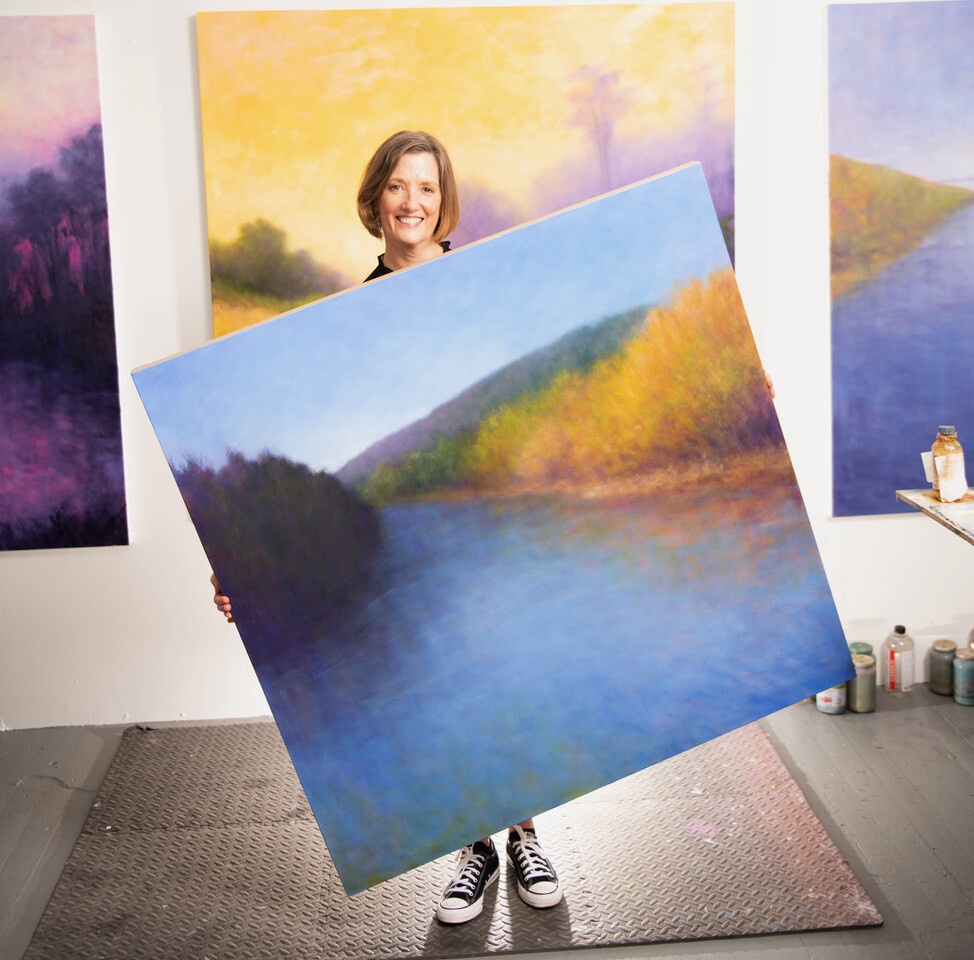
Places have a memory, a history, a feeling that we connect with. These memories, like faint echoes, are revealed as light moves across the landscape, transforming the color and texture of a place. It is these moments and experiences that I capture in my atmospheric landscape paintings.
My fascination with the landscape stems more from an interest in exploring our primal connection to the land rather than a focus purely on the aesthetics of a place. My paintings trace the effect light has on a location, how it leaves its mark on the landscape, how it illuminates the essence of nature–creating different moods, transforming a scene, drawing us in, focusing our gaze, changing the temperature physically and emotionally, and capturing movement. Combined, these elements relay the feeling and memories of a place. My paintings are a snapshot of a particular moment in time. Recording these moments is an act of resistance documenting places that are threatened by increased urbanization and catastrophic climate change. They are a call to preserve these places and a reminder of the important symbiotic relationship that we have with nature.
Travel is an integral part of my process. Participating in artist residencies around the world (Japan, India, Finland, and Iceland) allows me to explore different landscapes and record the dramatic shifts in light and color in various geographic locations. During long walks, I immerse myself in the feel and texture of a place recording my observations in photographs and small studies. These studies become the basis for my series.
Using oil paint on canvas, paper, or wood panel, I begin with loose under-paintings of bright pink or yellow that will peak through the final layers. Successive layers of color build to create ethereal luminescent compositions that reveal the emotional feel of a place. Light is the focus of my compositions, the real subject of my work.
Ultimately my work is about chronicling timeless moments in nature where we feel a sense of serenity and a connection to the land. This is the gift I want to share with you.
Veedell.com | Instagram: @victoria_veedell
Hi, I'm Victoria Veedell. Midsummer Morning is part of an ongoing series of paintings inspired by my morning walks through the Presidio here in San Francisco. I cherish the quiet of those early mornings. The park feels hushed and alive all at once. Every morning, the light reveals something new. The atmosphere shifts constantly, so I never know exactly what I'll encounter in terms of light or color. I walk slowly, staying present and paying attention to the subtle changes. The way light filters through the trees, how fog might soften the landscape. I often take dozens of photographs, which serve as a kind of visual memory once I'm back in the studio. My process begins with a warm under painting, usually in hot pink, and sometimes yellow, to establish a glowing foundation. I block in the shades, lay in the darkest darks, and then wipe out areas to create highlights, leaving traces of that initial stain behind. From there, I build up the painting in successive layers of oil paint, working back and forth between dark and white. The goal is to create a painting that glows from within, one that holds the quiet, immersive energy I felt on the path that morning. I hope viewers feel a sense of stillness and connection when they look at midsummer morning. The painting isn't about a specific place as much as it is about a feeling of being present, of witnessing a fleeting moment in nature. I want the work to invite people to slow down and take a breath, to really look and maybe even recall a quiet morning of their own. In a world that moves so quickly, I hope this piece offers a pause, a moment of reflection, calm, and beauty.
Place a DOT on the image


